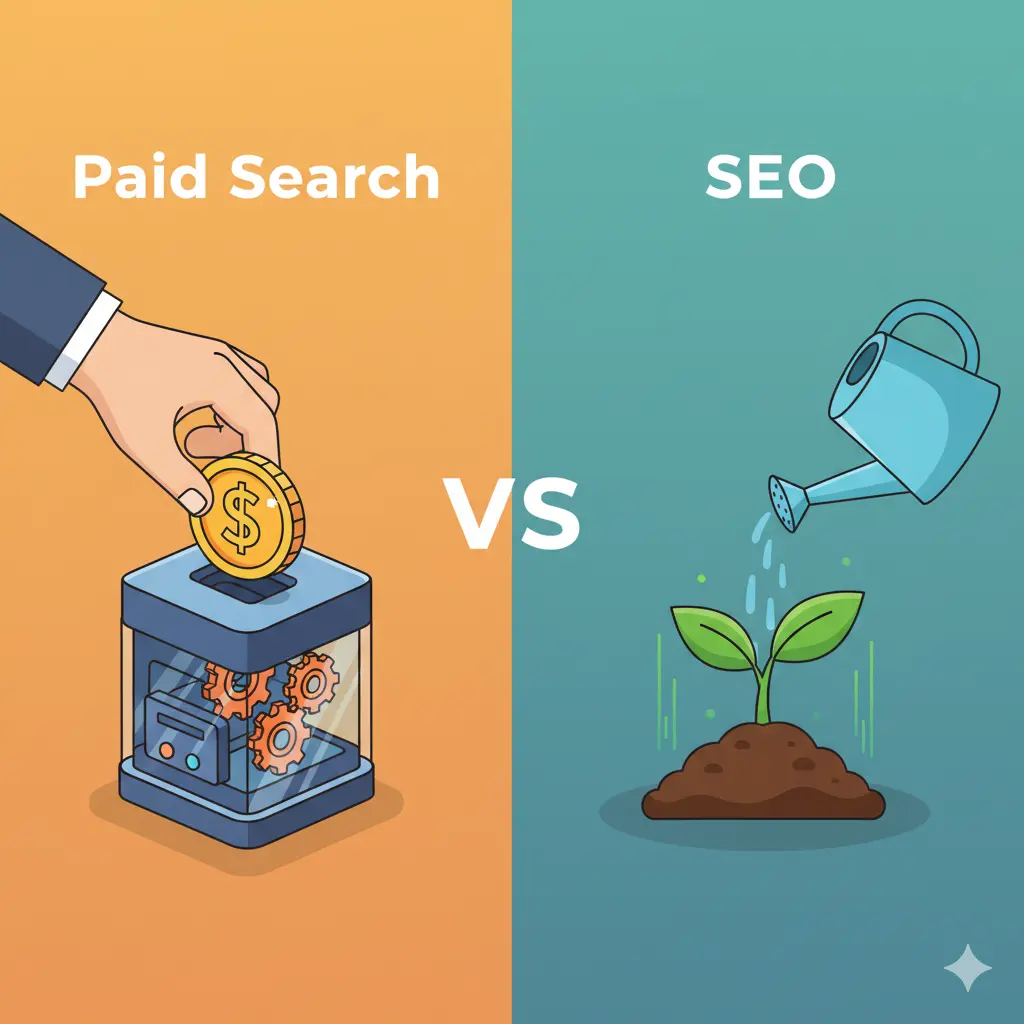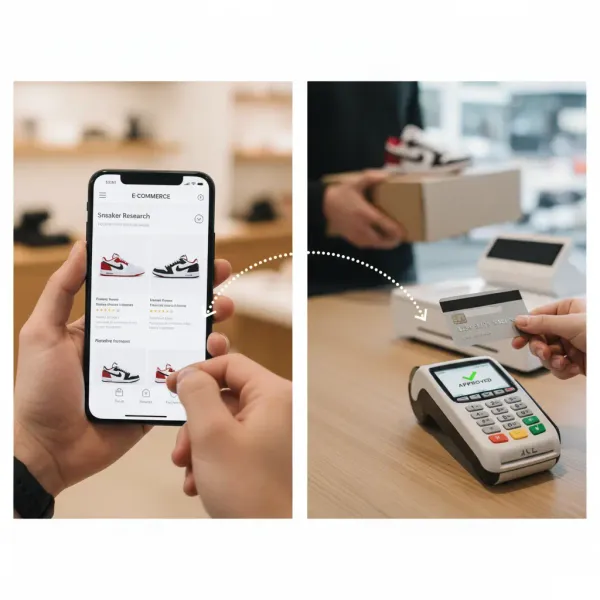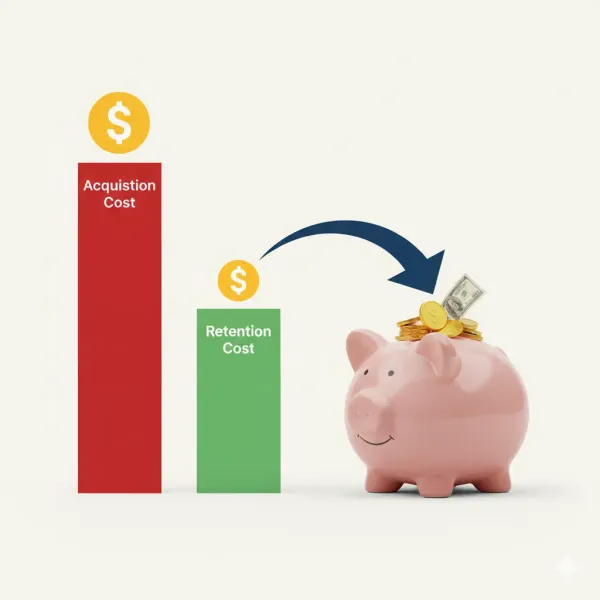Paid vs. SEO: The Ultimate Guide for Small Businesses on How to Start Growing a Website
A small business owner's guide to search engine marketing. Learn the key differences between paid search (PPC) and SEO, and how to create a winning, integrated strategy that drives traffic and growth.

A great digital marketing strategy for a small business needs to be more than just throwing money at ads or writing a few blog posts. The most effective approach combines both paid search and SEO (Search Engine Optimization) into a single, cohesive strategy. A 2019 study by BrightEdge research showed that of all visitors to a company website, 53% came from SEO and 27% came from paid search. While they both aim to increase your website's visibility on search engines like Google, they work very differently and require distinct tactics. Understanding these differences and how to leverage them together is key to driving sustainable, high-quality traffic to your site.
The Core Difference: You Pay for One, You Earn the Other
At its simplest, paid search (also known as Pay-Per-Click or PPC) is an advertising model where you pay to have your website appear at the top of search engine results pages (SERPs). You're essentially buying a spot for specific keywords. With SEO, you're working to earn that spot organically, which means you don't pay for the click itself. This is done by creating high-quality, relevant content that search engines deem valuable enough to rank highly on their own.
- Paid Search: The Fast Lane 🏎️
- Cost: You pay per click or impression.
- Speed: Instant visibility. You can set up a campaign and start getting traffic within minutes.
- Control: You have full control over your ads, keywords, and audience targeting.
- Sustainability: When you stop paying, your traffic from that source stops immediately.
- SEO: The Marathon 🏃♀️
- Cost: You pay for the time, effort, and tools to create and optimize content.
- Speed: It takes time. It can be weeks or months before you see significant ranking improvements.
- Control: You influence your rankings through content quality and technical optimization, but ultimately, the search engine decides your rank.
- Sustainability: Once you rank, your traffic can be a long-term, free source of leads, provided you maintain your content's relevance.
Why a One-Size-Fits-All Approach Fails
Many small business owners make the mistake of trying to apply the same strategy to both paid and organic search, but this is a critical error. The very nature of how they operate demands different tactics.
For example, in SEO, you might focus on topic clusters and a thoughtful website architecture. This means building a hub page (e.g., "Digital Marketing for Small Businesses") and supporting it with "spoke" pages (e.g., "Email Marketing Tips," "Social Media Strategy," "SEO Basics"). This structure signals to Google that your site is a comprehensive authority on a subject, boosting your overall rankings. You also need to pay attention to your URL conventions, ensuring they are clean, descriptive, and include your target keywords. Consistency here builds a foundation of trust with both users and search engines.
On the paid search side, the focus shifts to query intent and localization. A user searching for "best coffee shops" has a different intent than one searching for "how to brew coffee at home." With paid search, you bid on keywords that align with the user's intent. Someone searching for "coffee shop near me" is highly likely to convert, so you'd want to bid more on that phrase. You also use negative keywords to prevent your ads from showing for irrelevant searches (e.g., excluding "franchise" if you're not a franchise). This level of precision is crucial for maximizing your return on ad spend.
The two strategies diverge further when you consider the user's journey. Someone who clicks on a paid ad is often at the end of the buyer's journey, ready to make a purchase or book an appointment. The content on your landing page should be concise, persuasive, and feature a strong call to action. In contrast, a user who finds your blog post via an organic search is often in the research phase. They're looking for information, not a sales pitch. Your SEO content should be informative and helpful, building trust and positioning your business as a valuable resource.
Building a Winning, Integrated Strategy
The key to success isn't choosing one over the other; it's using them in tandem. Here's how to create a strategy that leverages the strengths of both paid and organic search:
- Use Paid Search to Test SEO Keywords: Instead of waiting months to see if a keyword will drive traffic organically, run a paid search campaign for it. If the keyword performs well and drives conversions, you have a strong signal that it's a valuable term to invest in for your long-term SEO strategy.
- Fill the Gaps with Paid Search: You won't rank for every high-value keyword immediately. Use paid search to capture traffic for those competitive terms while your SEO efforts are still in progress.
- Reinforce Brand Authority: When a user sees your business at the top of the paid search results and organically in the search snippets, it creates a powerful sense of authority and trustworthiness. This "double-dip" effect can significantly increase your click-through rate.
- Use Organic Insights to Refine Ad Copy: As your blog posts and other organic content start to rank, pay attention to the language and phrases that resonate most with your audience. Use these insights to craft more compelling and effective ad copy for your paid campaigns.
The Impact on Your Bottom Line
So, why does this matter for a small business? The difference between a fragmented marketing approach and an integrated one is night and day. A business that understands the unique roles of paid search and SEO can:
- Gain a competitive edge: By dominating search results from both paid and organic sources, you can box out competitors and capture a larger share of the market.
- Improve ROI: You'll stop wasting money on inefficient paid campaigns and start seeing a better return on your ad spend. Simultaneously, your long-term investment in SEO will pay off with a steady stream of free, high-quality traffic.
- Build a Sustainable Brand: The trust and authority you build through a strong organic presence will last long after a paid campaign ends. This is the difference between a quick sale and a loyal customer.
Ultimately, paid search and SEO are two sides of the same coin. They are powerful on their own, but truly unstoppable when you use them together to create a comprehensive and sustainable digital marketing strategy.


